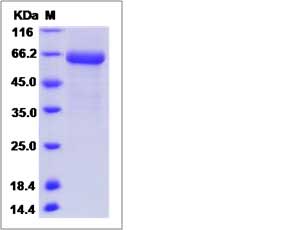Rhesus FCN1 / FCNA Protein (Fc Tag)
FCN1,FCNA
- 100ug (NPP2948) Please inquiry
| Catalog Number | P90154-C02H |
|---|---|
| Organism Species | Rhesus |
| Host | Human Cells |
| Synonyms | FCN1,FCNA |
| Molecular Weight | The recombinant rhesus FCN1 consists of 538 amino acids and predicts a molecular mass of 59.1 kDa. |
| predicted N | Ala 30 |
| SDS-PAGE |  |
| Purity | > 90 % as determined by SDS-PAGE. |
| Protein Construction | A DNA sequence encoding the rhesus FCN1 (XP_001098002.1) (Met1-Ala326) was expressed with the Fc region of human IgG1 at the C-terminus. |
| Bio-activity | |
| Research Area | Immunology |Signal Transduction |Cytoskeleton / ECM |Cell Adhesion |Lectin |C-tyep lectin | |
| Formulation | Lyophilized from sterile PBS, pH 7.4. 1. Normally 5 % - 8 % trehalose, mannitol and 0.01% Tween80 are added as protectants before lyophilization. Specific concentrations are included in the hardcopy of COA. |
| Background | Ficolins are humoral molecules of the innate immune systems which recognize carbohydrate molecules on pathogens, apoptotic and necrotic cells. The Ficolin family of proteins are characterized by the presence of a leader peptide, a short N-terminal segment, followed by a collagen-like region, and a C-terminal fibrinogen-like domain. Ficolins are humoral molecules of the innate immune systems which recognize carbohydrate molecules on pathogens, apoptotic and necrotic cells. Three Ficolins have been identified in humans: L-Ficolin, H-Ficolin and M-Ficolin (also referred to as Ficolin-2, -3 and -1, respectively). They are soluble oligomeric defence proteins with lectin-like activity and they are structurally similar to the human collectins, mannan-binding lectin (MBL) and surfactant protein A and D. Dysfunction or abnormal expressions of Ficolins may involved in the pathogenesis of human diseases including infectious and inflammatory diseases, autoimmune disease and clinical syndrome of preeclampsia. They are soluble oligomeric defence proteins with lectin-like activity and they are structurally similar to the human collectins, mannan-binding lectin (MBL) and surfactant protein A and D. Upon recognition of the infectious agent, the Ficolins act through two distinct routes: initiate the lectin pathway of complement activation through attached serine proteases (MASPs), and a primitive opsonophagocytosis thus limiting the infection and concurrently orchestrating the subsequent adaptive clonal immune response. Ficolin-1 (FCN1) is predominantly expressed in the peripheral blood leukocytes. |
| Reference |
